Attached files
| file | filename |
|---|---|
| 8-K - FORM 8-K - SCHLUMBERGER LIMITED/NV | h84442e8vk.htm |
Exhibit 99.1
SIMMONS AND COMPANY ENERGY CONFERENCE 2011 PAAL KIBSGAARD, SCHLUMBERGER
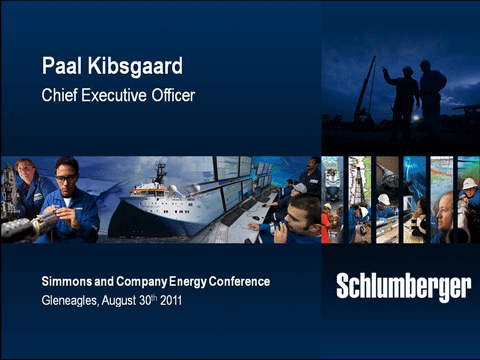
Good evening ladies and gentlemen.
I would like to start by thanking Simmons and Company and Bill Herbert in particular for the
invitation to speak at this conference. It is an honor for me to be here as the new CEO of
Schlumberger, a position I assumed at the beginning of this month. Before I start let me say that
Andrew and I share a common view of the future direction of Schlumberger and I am looking forward
to leading the implementation of the strategies and plans we have established.
This evening I intend to convince you that in spite of the market turmoil and short-term
uncertainty we currently face, the fundamentals of oil and gas remain solid and the case for
investing in the leading oilfield services company remains strong.
I will do this by first reviewing the macro environment for oil and gas and show that in the medium
term the supply situation is likely to remain tight for both oil and gas. The theme of increasing
complexity in finding and developing hydrocarbons also remains very valid and will require science
and technology to play even more important roles going forward.
Second I will outline how Schlumberger’s scientific depth and technical ability puts us in a unique
position to outperform the market in both top-line growth and margin expansion.
We continue to approach every aspect of our business whether internal or external process or
technology by investing the time and scientific resources to understand and solve the fundamentals
of any challenge. This
1
SIMMONS AND COMPANY ENERGY CONFERENCE 2011 PAAL KIBSGAARD, SCHLUMBERGER
will always ensure the long-term success of our customers and our shareholders and in my remarks I
will give examples of the scientific approaches we are taking in our major markets.
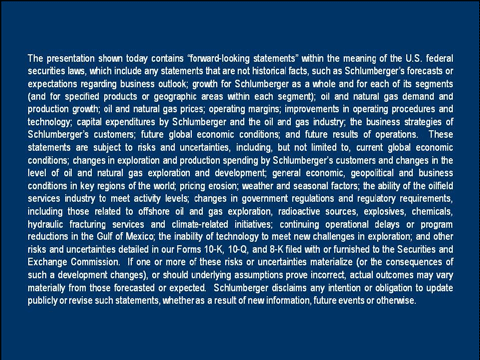
Some of what I will be saying this evening may contain statements that are forward-looking. Actual
results may differ materially and you are invited to see our latest filings. With that let’s then
look at the macro environment.
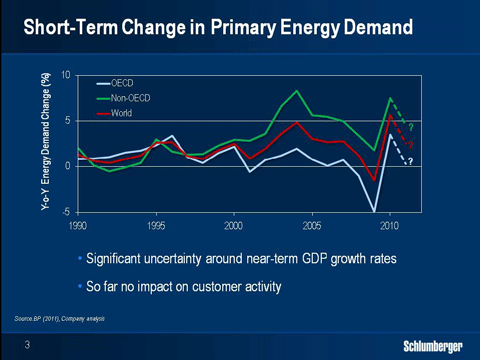
2
SIMMONS AND COMPANY ENERGY CONFERENCE 2011 PAAL KIBSGAARD, SCHLUMBERGER
In the past two years our industry has seen significant volatility with the largest year-on-year
fall in global energy demand in two decades followed by the largest recovery ever seen. This year
the world and our industry have faced major natural disasters and political unrest. And over the
past months the financial markets have been significantly impacted by
both the sovereign debt crisis in parts of the Eurozone as well as the US debt situation.
As a result, the 2011 and 2012 growth forecasts for the major OECD countries have seen significant
downward revisions. Inflation pressure in some of the key non-OECD countries is also causing
concern. The time needed to work through the current market situation remains unclear at this stage
and will be a function of the measures taken by the US and the Eurozone countries. In the near
term, there will likely continue to be uncertainty around the GDP growth rates.
So far we have not seen any impact on the activity plans of our customers but we continue to
monitor the situation closely and are ready to adjust our plans if required.
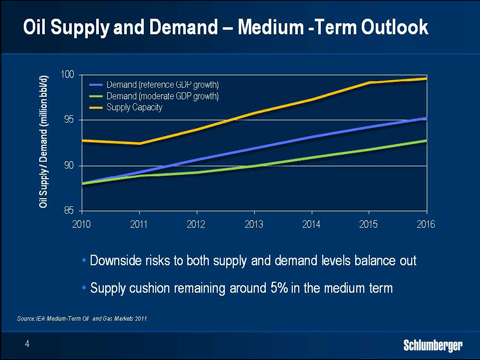
Looking at oil demand beyond the current turmoil, the recently published IEA Medium Term Report
represents the latest update. In their reference case of 4.5 percent annual growth in global GDP
the IEA forecasts an increase in oil demand of more than 7 million barrels per day between 2010 and
2016 to reach 95 million barrels per day.
3
SIMMONS AND COMPANY ENERGY CONFERENCE 2011 PAAL KIBSGAARD, SCHLUMBERGER
A lower GDP growth rate of 3.3 percent would reduce the demand growth by 2 million barrels per day.
In terms of supply, the IEA reference case forecasts global oil supply capacity to increase to
nearly 100 million barrels per day over the 7-year period, overcoming an annual decline in
production of about 3.2 million barrels per day.
This would leave a spare production capacity of around 5 million barrels per day, or 5 percent of
total demand. In the reference case, the IEA assumes that application of new technology can reduce
the annual decline rate in the aging non-OPEC production base by more than 1 percentage point
compared to the 2009 mid-term forecast.
While this number could be technically feasible, it may require significantly higher investments
than that currently assumed. The growth in supply further assumes that the new field developments
in both OPEC and non-OPEC remains on track without any delays, and also that there are no other
major supply disruptions from political or other unforeseen events.
So in summary the IEA reference case for oil indicates that the supply and demand balance will
remain tight in the medium term. And while there are downside risks on the demand side in the near
term, there are also risks on the supply side leaving the overall reference case quite balanced in
our view.
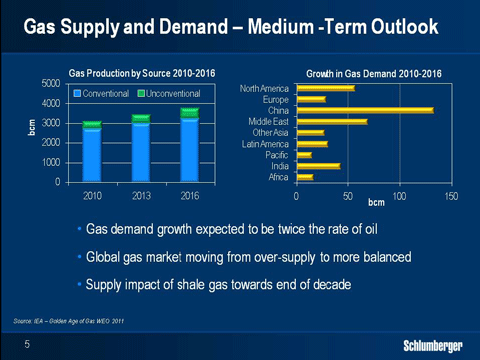
Let’s then turn to natural gas.
After a 2.5 percent drop in 2009, world gas demand increased by 7.4 percent in 2010, one of the
highest annual growth figures in 40 years. In
4
SIMMONS AND COMPANY ENERGY CONFERENCE 2011 PAAL KIBSGAARD, SCHLUMBERGER
2010, LNG-demand increased by 25 percent, which is the largest increase in recent history to reach
9 percent of global gas demand. The IEA medium-term outlook forecasts a growth in gas demand of 2.5
percent per year over the next 5 years, which is twice the rate of oil.
Asia remains the main engine for the demand growth, followed by the Middle East while OECD growth
is revised downwards from 1.3 percent to 0.5 percent per year. Ignoring the short-term
uncertainties in GDP growth, the global gas market is moving from a situation of oversupply towards
being more balanced.
Global LNG demand continues to grow with much of the new Qatar production already being absorbed by
the market. Looking at the supply side, the medium-term growth will mainly come from non-OECD
countries with the Former Soviet Union having the largest share followed by the Middle East. In the
OECD countries most of the growth will come from Australia, which will be the world’s second
biggest LNG producer by the end of this decade.
Conventional gas will continue to play a central role in the coming 5 years making up more than 85
percent of the total gas supply. In terms of unconventional gas, the EIA estimates that production
from shale gas now makes up 25 percent of US gas production, and that this percentage will continue
to grow.
The EIA also estimates that international shale gas resources are six times higher than those of
the US. At this stage international shale gas activity remains focused on exploration and pilot
projects but activity will ramp up in the coming years and shale gas will start to have an impact
on international supply towards the end of this decade. I will discuss shale gas in more detail
later in my presentation.
5
SIMMONS AND COMPANY ENERGY CONFERENCE 2011 PAAL KIBSGAARD, SCHLUMBERGER
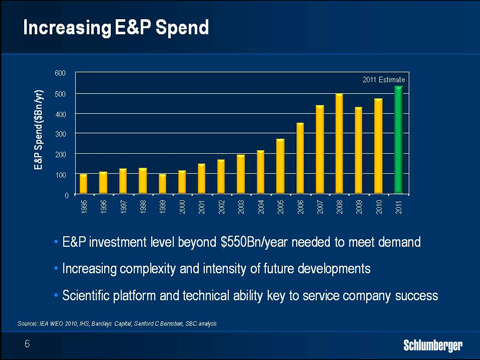
As an oilfield services company, our growth is a direct function of our customers’ exploration and
production spending. In 2010 the IEA estimated that total E&P spending of around 550 billion
dollars per year, corrected for future inflation, would be needed to address future oil and gas
supply.
Given the increasing complexity and intensity of finding and developing new reserves as well as
maintaining production from existing fields, we believe that this number most likely will need to
be higher. We also believe that going forward, the integrated oilfield services companies will play
an even more important role in extracting the full potential of
existing and new hydrocarbon resources and that our share of the future spending will likely
increase.
Finally we believe that the oilfield services companies that best help their customers to de-risk
and drive the financial performance of their projects will ultimately be the most successful. Our
approach to this challenge is to apply our unique scientific platform and technical abilities to
all parts of our business supported by an R&D investment of over one billion dollars per year.
To further illustrate how we apply our scientific platform in driving market outperformance, I will
outline our approach to four key market opportunities—exploration, drilling, deepwater and
unconventional shale resources—highlighting what sets us apart from the rest of the market
players.
So let’s start off with exploration.
6
SIMMONS AND COMPANY ENERGY CONFERENCE 2011 PAAL KIBSGAARD, SCHLUMBERGER
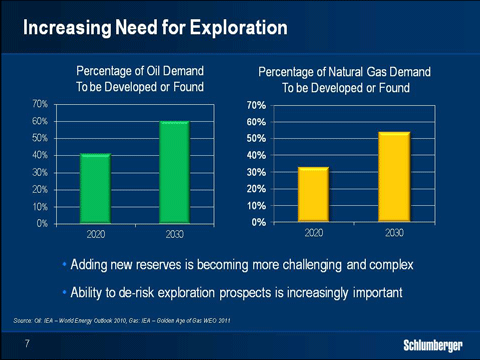
The importance of higher exploration activity is best illustrated by the growing supply challenge
the industry is facing. In their reference case, the IEA estimates that around 40 percent of the
oil production needed by the end of this decade has yet to be found or developed.
By 2030 this figure will likely have climbed to 60 percent, with natural gas resources showing
similar trends. Adding future reserves is becoming more complex and intense from a technology
standpoint and is associated with additional costs and risks.
As an example, in the last ten years more than half of the new oil and gas reserves discovered
worldwide have been offshore and this trend is likely to continue. The pursuit of finding new
reserves is also taking us to deeper waters and deeper targets often hidden below complex salt
structures such as in the Gulf of Mexico, Brazil and West Africa.
Hence the ability to de-risk exploration prospects prior to drilling becomes more and more
important.
7
SIMMONS AND COMPANY ENERGY CONFERENCE 2011 PAAL KIBSGAARD, SCHLUMBERGER
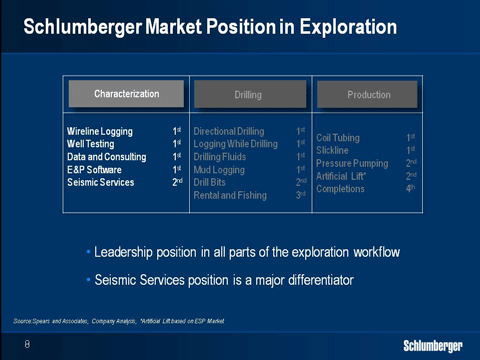
Today, Schlumberger is the clear leader in all parts of the exploration workflow from modeling
software to high-end wireline and well testing services. Still it is our leadership position within
seismic services that is most unique compared to our competitors.
Establishing a clear picture of the subsurface and potential prospects will always be the starting
point of any successful exploration campaign. Building on our science and technology platform, we
continue to advance
our ability to illuminate the subsurface helping our customers to identify and de-risk exploration
targets.
8
SIMMONS AND COMPANY ENERGY CONFERENCE 2011 PAAL KIBSGAARD, SCHLUMBERGER
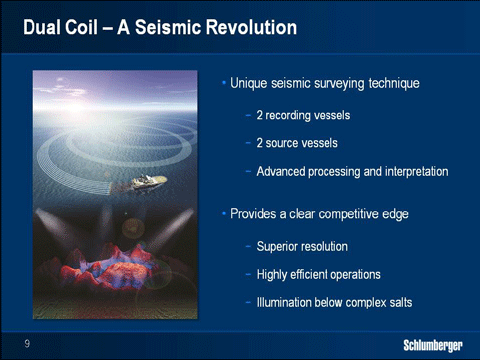
At this conference in 2009, Andrew introduced a new seismic technique called Coil Shooting in which
a vessel sails in overlapping circles while continuously recording data.
This technique delivers higher-fold and full-azimuthal coverage, and is also highly cost-effective
as the downtime when a conventional spread turns to do another pass is completely eliminated.
Building on the initial success of the Coil Shooting technique where one vessel was utilized, we
have recently introduced a further development called Dual Coil.
This technique involves two recording vessels each with their own source as well as two separate
source vessels all sailing in the same interlinked circles creating unprecedented illumination of
deep and complex exploration targets. Schlumberger is the only company offering the Dual Coil
technique due to our technology leadership in streamer steering and positioning, single-sensor
recording, noise removal and processing and interpretation.
To date Coil and Dual Coil surveys have been completed in the Gulf of Mexico, Brazil, Angola and
the North Sea.
9
SIMMONS AND COMPANY ENERGY CONFERENCE 2011 PAAL KIBSGAARD, SCHLUMBERGER
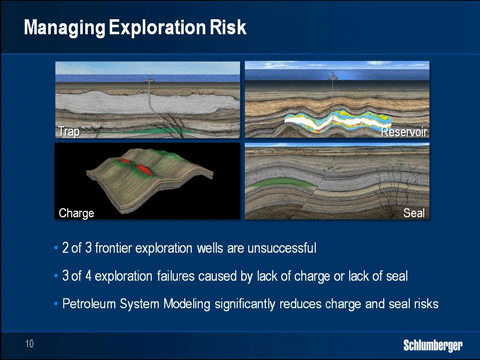
In terms of worldwide exploration success, on average two out of three frontier exploration wells
are today unsuccessful. This indicates that in spite of the advances in seismic technology, the
industry still fails to properly manage exploration risk. It has long been our belief that
exploration prospects can be further de-risked by combining seismic data with petrophysical well
data and petroleum system modeling to better understand the four components of trap, reservoir,
charge and seal.
While seismic technology advances have made significant contributions to better evaluate trap and
reservoir risks, almost three-quarters of the dry exploration wells are due to inadequate
understanding of seal and charge risks. Petroleum system modeling enables geoscientists to better
simulate migration, entrapment and preservation of hydrocarbons, which again addresses these risks.
10
SIMMONS AND COMPANY ENERGY CONFERENCE 2011 PAAL KIBSGAARD, SCHLUMBERGER
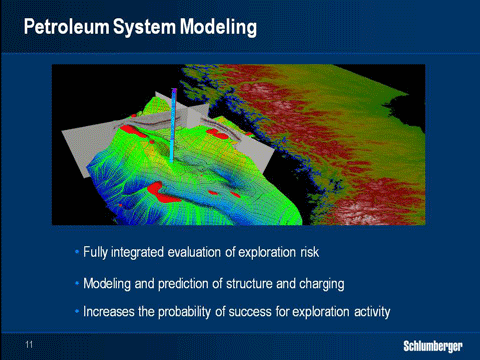
As the only provider we now offer a fully software enabled workflow covering seismic and
petrophysical interpretation as well as petroleum system modeling. In this example from the North
Sea, you see the predicted gas and oil accumulations in red and green in a Petrel model built using
this integrated workflow.
The green lines indicate the flow paths of the liquid hydrocarbons predicted to have charged these
structural traps. Clearly the ability to model and predict both structure and charging of potential
reservoirs has huge potential to de-risk exploration targets.
Building on our scientific platform, we continue to invest heavily in this area to further extend
our leadership position. So with that let’s move from exploration to drilling.
11
SIMMONS AND COMPANY ENERGY CONFERENCE 2011 PAAL KIBSGAARD, SCHLUMBERGER
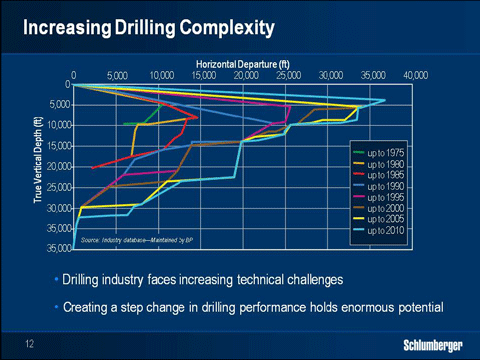
Over the past ten years we have seen a doubling in the number of land and offshore rigs operating
worldwide. And as already discussed, the drilling targets are generally found deeper with more
challenging well profiles and higher pressures and temperatures all representing tougher and more
complex drilling.
And these trends are set to continue. There is therefore enormous potential value in creating a
step change in drilling performance for the industry.
This can be done by drilling faster when the drill bit is on bottom and by reducing the 10 billion
dollars per year of costs linked to drilling problems such as tool failures stuck pipe and lost
circulation.
12
SIMMONS AND COMPANY ENERGY CONFERENCE 2011 PAAL KIBSGAARD, SCHLUMBERGER
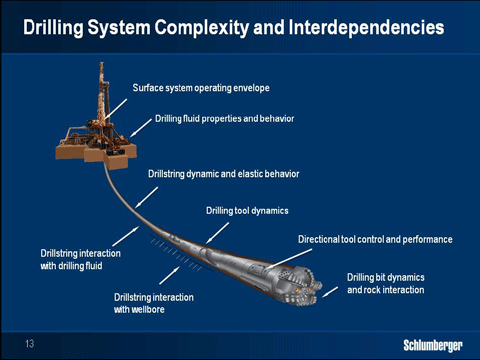
While the principle of drilling is relatively simple, the reality of the drilling process is highly
complex to understand and predict. The interactions between rig, drillstring, drilling fluid and
formation are all interdependent and vary rapidly as downhole conditions continuously change. Over
the past decades we have seen excellent examples of advances in individual drilling technologies
such as top drives, rotary steerable systems and PDC cutters.
Still the general approach to drilling optimization has changed little since the 1980s. We believe
that in order to create the next step change in drilling performance we need to take a systems
approach and move the entire drilling process from being partly a form of art to becoming a
full-fledged science.
13
SIMMONS AND COMPANY ENERGY CONFERENCE 2011 PAAL KIBSGAARD, SCHLUMBERGER

One of the reasons why drilling remains partly a form of art is that few companies had the
technology span to embark on the transformation. And the ones that had, lacked the scientific
platform or the ambition.
With the 12 billion dollars we spent last year on the Smith and Geoservices transactions, we are
now uniquely positioned to take on this challenge building on clear leadership positions in most of
the significant drilling segments.
In terms of the Smith integration, progress has been outstanding to the point that the transaction
was accretive to our earnings per share in the second quarter, almost one year earlier than
initially planned.
At this stage, we are already in full process of transforming drilling into a full-fledged science
by focusing on the following four elements:
14
SIMMONS AND COMPANY ENERGY CONFERENCE 2011 PAAL KIBSGAARD, SCHLUMBERGER
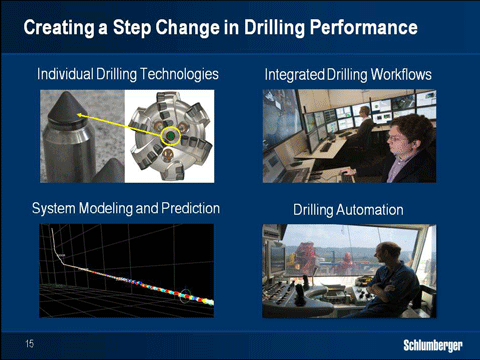
First, we continue to invest heavily in the development of new individual drilling technologies
combining the capabilities of all our drilling segments. We have already made significant progress
in the past 12 months and in the coming years we will introduce a wide range of new advanced
technologies to the market.
Second, we are creating the drilling industry’s most powerful technical community by co-locating
all our drilling experts residing in our GeoMarkets into drilling support centers. In these centers
the planning and upfront design of the wells we drill is done together with our customers and we
also monitor and support the wellsite operations in real time.
By the end of this year we will have 10 of these drilling support centers established ramping up to
30 by the end of 2012. Third, we have some of our brightest minds working on creating numerical
models able to predict the behavior of the entire drill string as a function of changing surface
and downhole parameters.
In this work we benefit from our extensive experience in high-volume data processing inversion
techniques and system modeling, and early versions of these models are already being tested today.
Finally we believe that the ultimate step change in drilling performance will come from automation
where real-time measurements are fed into the numerical models which again control the key drilling
parameters.
15
SIMMONS AND COMPANY ENERGY CONFERENCE 2011 PAAL KIBSGAARD, SCHLUMBERGER
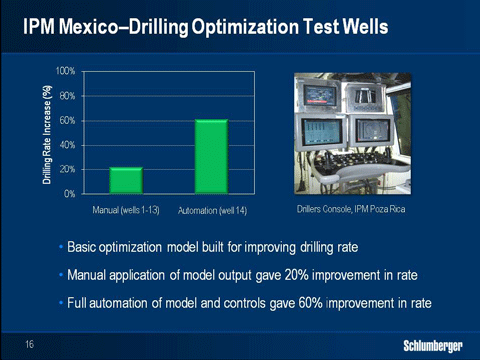
The move towards drilling automation will need to be handled with caution and the drilling process
will always involve human oversight and potential intervention similar to how airline pilots
operate today.
To illustrate the potential of numerical drilling models and drilling automation let’s look at an
example from one of our IPM projects. Here we built a simple numerical model to optimize the
drilling rate as a function of weight-on-bit and the rotational speed of the drill pipe, and we
applied the output of the model to 14 wells in real time.
For the first 13 wells, the model output was fed to the driller who was requested to enter the
settings manually into the rig controls resulting in an average improvement in drilling rate of
around 20%. In the 14th well, the model output was fed directly into the rig controls without any
human interaction giving more than 60% improvement in drilling rat—significantly higher than the
wells operated manually.
The model used in this example was quite basic but it gives a good indication of the upside
potential science can realize in drilling.
And Schlumberger has both the ability and the ambition to lead the transformation of the drilling
process into a full-fledged science.
16
SIMMONS AND COMPANY ENERGY CONFERENCE 2011 PAAL KIBSGAARD, SCHLUMBERGER
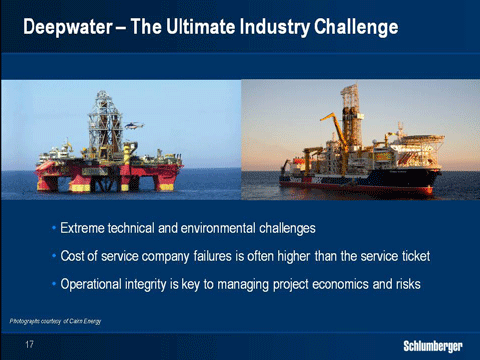
Let’s then turn to deepwater, which poses the ultimate challenge for our industry in terms of both
costs and risks. With the very high day rates of the latest-generation deepwater rigs, the cost of
service company operational failures often dwarfs the service company tickets.
The Deepwater Horizon incident has further stressed the importance and value of operational
integrity from the service industry. Services such as seismic, wireline, directional drilling and
well testing, all play critical parts in deepwater developments.
Schlumberger is today the clear leader in the deepwater market and this is a position we have
earned by taking a scientific approach to all aspects of our operations.
17
SIMMONS AND COMPANY ENERGY CONFERENCE 2011 PAAL KIBSGAARD, SCHLUMBERGER
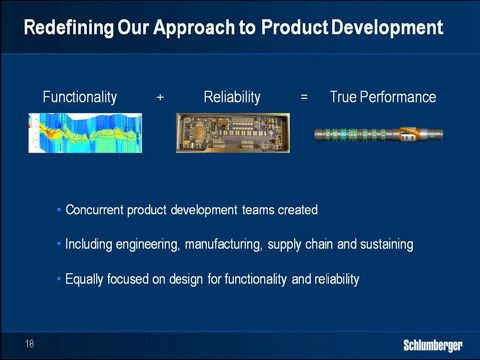
In 2007, we embarked on a long-term program called “Excellence in Execution” with the ultimate goal
of elevating our operational performance to a completely new level. Through “Excellence in
Execution” we are both extending our basic technology lead by re-shaping our approach to product
development,t as well as re-defining the consistency of our wellsite operations.
To extend our technology lead, we focus on functionality, which is what the technology is able to
do when it works properly, as well as on reliability, which is how the technology actually works.
In our new approach to product development, we build on best practices from the automotive and
aerospace industries to drive both functionality but even more so, the reliability of our
technology.
Many of our competitors will claim to have comparable technologies to us on the basis of
functionality alone. However, when overlaying the functionality with the reliability of the
technology it quickly becomes clear that this is not the case.
18
SIMMONS AND COMPANY ENERGY CONFERENCE 2011 PAAL KIBSGAARD, SCHLUMBERGER
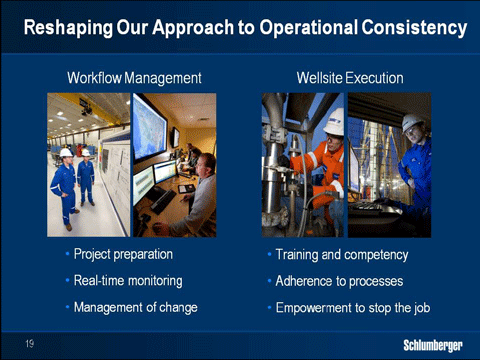
In terms of the consistency of our wellsite planning and execution, we focus on both competency and
workflow management. Prior to 2007 we already had a well established training and competency
management program covering every employee group and in particular our field population. In 2009 we
extended our program to monitor in detail the development of deepwater expertise in all our
technology lines and we put in place a deepwater competency certification process. Through this
program, we have rapidly grown a unique deepwater technical domain with the depth of expertise
needed to meet the growth in deepwater activity.
When it comes to workflow management, we have established detailed processes for project
preparation real-time monitoring and control as well as management of change and we require full
compliance to these processes from all our employees. In the event we are precluded from following
our standard operating procedures, we have also empowered every employee to shut down operations
and involve their manager onshore.
19
SIMMONS AND COMPANY ENERGY CONFERENCE 2011 PAAL KIBSGAARD, SCHLUMBERGER

When we combine our unique technology with the consistency in our wellsite delivery, we offer a
compelling proposition for managing costs and minimizing risks in the deepwater domain.
Over the past three years, we have already made significant progress in reducing the non-productive
time associated with our operations which has already been noticed by our customers. With the
growth in deepwater activity where the number of fields in production will reach 500 in 2015, our
lead in operational integrity provides another great opportunity to outperform the market.
20
SIMMONS AND COMPANY ENERGY CONFERENCE 2011 PAAL KIBSGAARD, SCHLUMBERGER
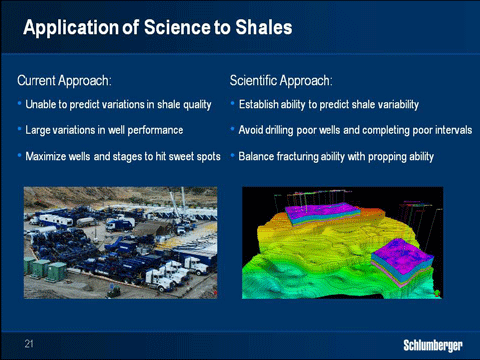
Let me then turn to unconventionals, where I will focus my comments on shale and how Schlumberger
continues to apply our wide scientific platform to optimize the development of these important
resources. The current industry approach to shale development in North America is sub-optimal, as
it involves significant cost and resource waste.
In general we see horizontal wells being spread evenly over the acreage with the entire horizontal
section completed and fractured with massive amounts of water proppant and hydraulic horsepower.
This approach would lead you to believe that the shale reservoir quality is constant. However both
core data and production results confirm that this is not the case. Shale reservoir quality,
similar to all other known hydrocarbon resources, varies both vertically and laterally.
The reason for the current approach is instead that the reservoir evaluation and prediction
workflows used for conventional resources have up until recently not been available for shales.
Shale as a productive reservoir on a large scale is new to the industry. And the standard logging
measurements interpretation techniques and modeling workflows used in sandstones and carbonates
cannot be directly applied.
Without these workflows we operate more or less blindly.
The industry solution has therefore been to maximize the coverage of the shale volume with wells
and stages with the hope of hitting enough of the ‘good stuff’ to reach reasonable levels of
production and recovery.
21
SIMMONS AND COMPANY ENERGY CONFERENCE 2011 PAAL KIBSGAARD, SCHLUMBERGER
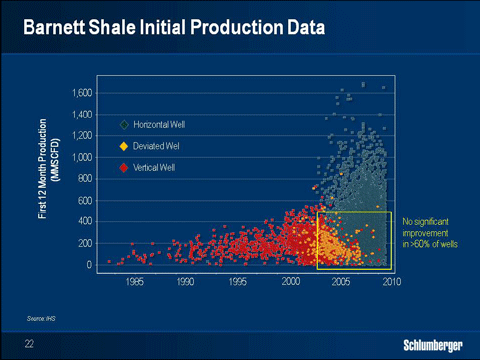
However as the industry continues to perfect the factory drilling and completion of horizontal
shale wells with ever increasing hydraulic fracturing intensity, it does not make up for the lack
of fundamental reservoir understanding of shale as resource. It is clear that the current
sub-optimal approach is associated with tremendous resource and cost waste as illustrated by the
production data from the Barnett shale.
This figure shows the production from the first 12 months for all the wells vertical, deviated and
horizontal completed since 1980. While the best performing horizontal wells clearly outperform
vertical and deviated wells, a high number of horizontal wells show no production improvement in
spite of much higher drilling and completions costs.
So let’s look at the three dimensions of cost and resource waste associated with the current
sub-optimal approach:
22
SIMMONS AND COMPANY ENERGY CONFERENCE 2011 PAAL KIBSGAARD, SCHLUMBERGER
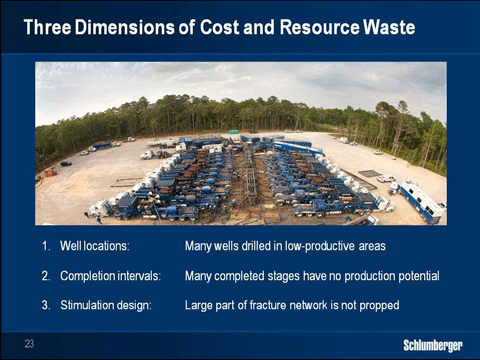
First, many wells are drilled in areas of the shale plays with poor production potential and
subsequent production results.
Second, the horizontal wells are completed along their entire lengths even though significant parts
of the horizontal section have no production potential as observed from actual production logs.
Third, the amounts of horsepower and water applied to each stage are excessive creating fracture
networks much deeper than what can be propped and where the un-propped part of the fracture network
closes as soon as the hydraulic pressure is released.
Simulations show that if the entire depth of the fracturing network was indeed contributing the
production from the average well should be three to four times higher.
23
SIMMONS AND COMPANY ENERGY CONFERENCE 2011 PAAL KIBSGAARD, SCHLUMBERGER
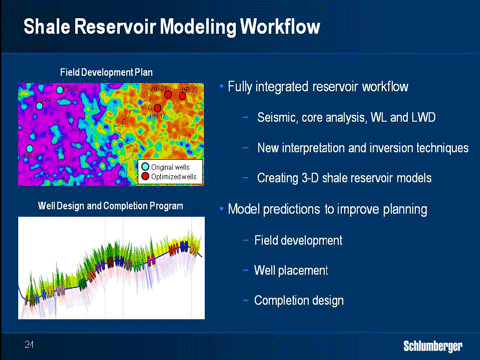
Building on our subsurface science strengths, we have now established a reservoir modeling workflow
for shale reservoirs. This workflow incorporates seismic core analysis and basic wireline and
logging-while-drilling measurements using unique modeling and data inversion techniques.
With this workflow we are now able to build three-dimensional reservoir models capable of
predicting variations in shale reservoir quality helping our customers to pick the best well
locations on their acreage.
The model, when coupled with wireline or logging-while-drilling measurements from the horizontal
sections, can also be used to select the optimum well path and completion intervals avoiding
spending time horsepower water and proppant on stages that have no production potential.
The figure in the top left shows an example where this workflow was used for a customer. The warmer
colors on the map are areas where our model predicted good shale quality, while the colder colors
show poorer shale quality.
Prior to building the reservoir model the customer had already drilled three wells in the poor part
of the shale. Based on the model, three new well locations where picked as seen on the map and they
all gave initial production rates that were three to four times higher than the three initial
wells.
We have now proven this technique for a number of customers in the US and the results have been
very positive. And we believe that this integrated
24
SIMMONS AND COMPANY ENERGY CONFERENCE 2011 PAAL KIBSGAARD, SCHLUMBERGER
workflow has the potential over time to transform the current industry approach.

When it comes to optimizing the stimulation design of each stage, the key is to balance the
extension of the fracture network created with the ability to prop it, to ensure that the fractures
remain open and contribute to production.
Hydraulic fracture monitoring and more advanced fracturing fluid systems like HiWAY are key
technologies that facilitate this. HiWAY continues to make inroads in the various shale basins in
the US as well as overseas and so far this year we have pumped around 2000 stages and saved more
than 135,000 tons of proppant.
As we continue to expand HiWAY into new shale basins, and our customers get more comfortable with
the use of the technology, we are also starting
to reduce the water volume and horsepower used in our jobs with very positive results.
In a recent job in the Barnett shale we reduced water and proppant volumes by around 40% each and
average horsepower by around 25% while the initial production was significantly higher than
expected. This is an excellent example of how we can achieve more with less by applying science.
We are already seeing signs that the scientific approach to shale developments is gaining momentum
and as the IOCs continue to build their positions in the shale basins both in the US, and overseas
this trend will only strengthen.
25
SIMMONS AND COMPANY ENERGY CONFERENCE 2011 PAAL KIBSGAARD, SCHLUMBERGER
The scientific approach will also be critical to unlock shale developments overseas as the industry
faces more public pressure to minimize the operational footprint and also less available
infrastructure compared to North America.
The onset of this scientific approach will elevate the importance of reservoir evaluation, drilling
and advanced fracturing fluid systems in future shale developments. And these are three technical
domains where Schlumberger holds clear leadership positions.
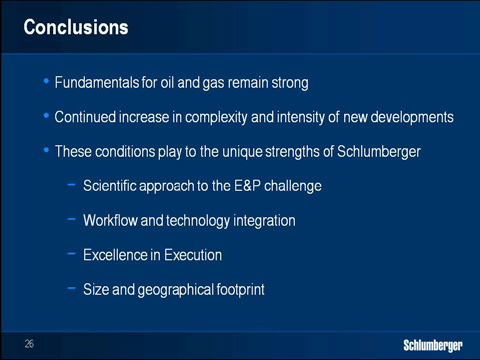
Ladies and gentlemen, in my presentation I have highlighted that in spite of the uncertainties in
short-term GDP growth, the fundamentals for oil and gas remain positive providing an underlying
trend of higher investments in exploration and production.
I have also illustrated that the slender supply-demand gap will drive our customers towards
resources that are more difficult to develop which will continue to increase the intensity and
complexity of the supply challenge.
Schlumberger has the broadest portfolio of technology and the largest pool of experience and talent
to help de-risk and drive the financial performance of our customers’ projects.
We further set ourselves apart by taking a scientific approach to all aspects of our business,
combined with fully integrated workflows and technologies and a commitment to excellence in
execution.
26
SIMMONS AND COMPANY ENERGY CONFERENCE 2011 PAAL KIBSGAARD, SCHLUMBERGER
And lastly our size and footprint advantage provides the required presence and critical mass as
exploration and development activity moves to new basins.
Building on these unique strengths and the opportunities I have outlined this evening, I am very
confident in our ability to outperform the market in both top line and margin growth.
Thank you.
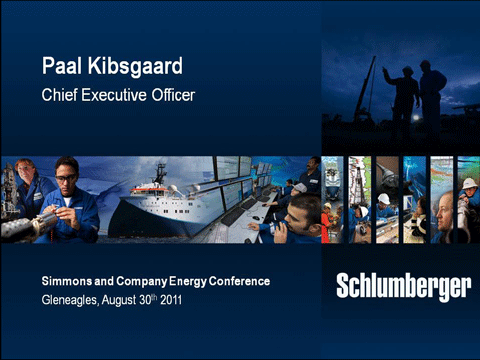
27
